Metformin downregulates the insulin/IGF-I signaling pathway and inhibits different uterine serous carcinoma (USC) cells proliferation and migration in p53-dependent or -independent manners
- PMID: 23620761
- PMCID: PMC3631250
- DOI: 10.1371/journal.pone.0061537
Metformin downregulates the insulin/IGF-I signaling pathway and inhibits different uterine serous carcinoma (USC) cells proliferation and migration in p53-dependent or -independent manners
Abstract
Accumulating epidemiological evidence shows that obesity is associated with an increased risk of several types of adult cancers, including endometrial cancer. Chronic hyperinsulinemia, a typical hallmark of diabetes, is one of the leading factors responsible for the obesity-cancer connection. Numerous cellular and circulating factors are involved in the biochemical chain of events leading from hyperinsulinemia and insulin resistance to increased cancer risk and, eventually, tumor development. Metformin is an oral anti-diabetic drug of the biguanide family used for treatment of type 2 diabetes. Recently, metformin was shown to exhibit anti-proliferative effects in ovarian and Type I endometrial cancer, although the mechanisms responsible for this non-classical metformin action remain unclear. The insulin-like growth factors (IGFs) play a prominent role in cancer biology and their mechanisms of action are tightly interconnected with the insulin signaling pathways. Given the cross-talk between the insulin and IGF signaling pathways, the aim of this study was to examine the hypothesis that the anti-proliferative actions of metformin in uterine serous carcinoma (USC) are potentially mediated via suppression of the IGF-I receptor (IGF-IR) pathway. Our results show that metformin interacts with the IGF pathway, and induces apoptosis and inhibition of proliferation and migration of USC cell lines with both wild type and mutant p53. Taken together, our results suggest that metformin therapy could be a novel and attractive therapeutic approach for human USC, a highly aggressive variant of endometrial cancer.
Conflict of interest statement
Figures
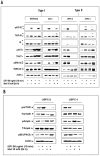
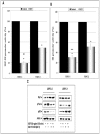
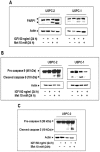
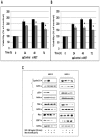
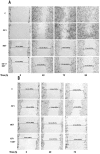
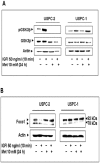
Similar articles
-
GSK3 protein positively regulates type I insulin-like growth factor receptor through forkhead transcription factors FOXO1/3/4.J Biol Chem. 2014 Sep 5;289(36):24759-70. doi: 10.1074/jbc.M114.580738. Epub 2014 Jul 22. J Biol Chem. 2014. PMID: 25053419 Free PMC article.
-
p53 Regulates insulin-like growth factor-I receptor gene expression in uterine serous carcinoma and predicts responsiveness to an insulin-like growth factor-I receptor-directed targeted therapy.Eur J Cancer. 2012 Jul;48(10):1570-80. doi: 10.1016/j.ejca.2011.09.014. Epub 2011 Oct 25. Eur J Cancer. 2012. PMID: 22033326
-
Resveratrol suppresses IGF-1 induced human colon cancer cell proliferation and elevates apoptosis via suppression of IGF-1R/Wnt and activation of p53 signaling pathways.BMC Cancer. 2010 May 26;10:238. doi: 10.1186/1471-2407-10-238. BMC Cancer. 2010. PMID: 20504360 Free PMC article.
-
[Molecular action of insulin-sensitizing agents].Endokrynol Pol. 2005 May-Jun;56(3):308-13. Endokrynol Pol. 2005. PMID: 16350724 Review. Polish.
-
Novel targeted therapies in uterine serous carcinoma, an aggressive variant of endometrial cancer.Discov Med. 2016 Apr;21(116):293-303. Discov Med. 2016. PMID: 27232515 Review.
Cited by
-
Metformin has heterogeneous effects on model organism lifespans and is beneficial when started at an early age in Caenorhabditis elegans: A systematic review and meta-analysis.Aging Cell. 2022 Dec;21(12):e13733. doi: 10.1111/acel.13733. Epub 2022 Oct 25. Aging Cell. 2022. PMID: 36281624 Free PMC article.
-
Benefits of Metformin in Attenuating the Hallmarks of Aging.Cell Metab. 2020 Jul 7;32(1):15-30. doi: 10.1016/j.cmet.2020.04.001. Epub 2020 Apr 24. Cell Metab. 2020. PMID: 32333835 Free PMC article. Review.
-
Intermittent and Periodic Fasting, Hormones, and Cancer Prevention.Cancers (Basel). 2021 Sep 13;13(18):4587. doi: 10.3390/cancers13184587. Cancers (Basel). 2021. PMID: 34572814 Free PMC article. Review.
-
Metformin inhibits gastric cancer cells metastatic traits through suppression of epithelial-mesenchymal transition in a glucose-independent manner.PLoS One. 2017 Mar 23;12(3):e0174486. doi: 10.1371/journal.pone.0174486. eCollection 2017. PLoS One. 2017. PMID: 28334027 Free PMC article.
-
Pilot Study Assessing Tolerability and Metabolic Effects of Metformin in Patients With Li-Fraumeni Syndrome.JNCI Cancer Spectr. 2020 Jul 18;4(6):pkaa063. doi: 10.1093/jncics/pkaa063. eCollection 2020 Dec. JNCI Cancer Spectr. 2020. PMID: 33490865 Free PMC article.
References
-
- Kitchener H (2006) Management of endometrial cancer. Eur J Surg Oncol 32: 838–843. - PubMed
-
- Attias-Geva Z, Bentov I, Kidron D, Amichay K, Sarfstein R, et al. (2012) p53 Regulates insulin-like growth factor-I receptor gene expression in uterine serous carcinoma and predicts responsiveness to an insulin-like growth factor-I receptor-directed targeted therapy. Eur J Cancer 48: 1570–1580. - PubMed
-
- Pallares J, Martinez-Guitarte JL, Dolcet X, Llobet D, Rue M, et al. (2004) Abnormalities in the NF-kappa B family and related proteins in endometrial carcinoma. J Pathol 204: 569–577. - PubMed
-
- Ryan AJ, Susil B, Jobling TW, Oehler MK (2005) Endometrial cancer. Cell Tissue Res 322: 53–61. - PubMed
MeSH terms
Substances
LinkOut - more resources
Full Text Sources
Other Literature Sources
Medical
Research Materials
Miscellaneous

